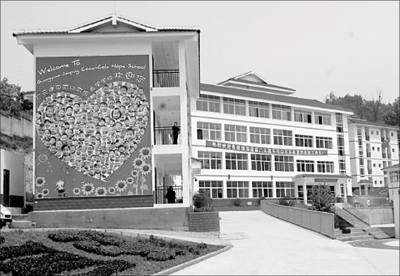 |
Large Medium Small |

BEIJING — For the past two years, Yang Jing, a ninth grade student from Jianping School in Sichuan province, has been struggling to forget the painful memories left by the deadly May 12 earthquake.
But now, standing in front of the multistoried new school building constructed in the same place where her school was smashed into pieces, the 14-year-old has finally found a reason to smile.
“I can’t wait to move into my new classroom. This is a new start for me and my schoolmates,” Yang said with a grin on her face.
Thanks to the 100 million yuan donation by Coca-Cola China and the help of China Youth Development Foundation (CYDF), the girl, together with other 900 children and teachers, was the first group to move into the well-equipped school building after studying in makeshift classrooms for two years.
By the end of 2011, the fund donated by Coca-Cola China will help build an additional 40 new schools across Sichuan, Yunnan, Shaanxi, Gansu and Ningxia in West China, provinces that were ravaged by the disastrous 8-maginitude earthquake in 2008.
Jianping School, the first to be launched as part of Coca-Cola’s three-year plan to help rebuild educational centers in the quake-stricken communities, is located in Lizhou district, Guangyuan city, one of the worst hit areas during the quake. It is about 280 km away from the provincial capital Chengdu.
As a district under Guangyuan city, Lizhou was not privileged to twin with other province to get financial support for reconstruction work, as other badly hit areas at county level did.
Because the disaster’s economic cost to Guangyuan was 24 billion yuan, 400 times the city’s government revenue annually, it encountered more financial difficulties during the post-quake reconstruction compared with its peers at county level.
Children had to wear boots in the prefab temporary classroom, as water often leaked from the roof on rainy days, Zhang Mei, a teacher at the school, said.
“Both Coca-Cola and the foundation decided to take places that are most in need of help as our top priorities, so we went to help reconstruct schools in Lizhou first,” Tu Meng, secretary general of CYDF, one of the chief organizers of Project Hope, a program launched 21 years ago to improve rural education.
Coca-Cola’s commitment to China’s rural education development started in 1993. During its 17 years of partnership with CYDF, the company has built 60 Project Hope Schools across the country.
Doug Jackson, president of Coca-Cola Greater China and Korea, said the opening of the new school marked a new chapter of Coca-Cola’s rural education project in China, as the school is equipped with comprehensive facilities, including computers, a library, a student dormitory, canteen and various sports equipment.
“Our goal is to provide more than just basic education facilities but the best possible environment for all-round development of the children,” he said.
Over the years, Coca-Cola’s support for Project Hope has also extended beyond the provision of facilities. The company has provided training for nearly 1,000 school teachers in an effort to improve the teaching quality in the country’s rural areas.
In response to the shocking Qinghai earthquake on April 14, the company made an immediate donation of 1 million yuan through CYDF and is still actively looking for ways to provide further support.
It also plans to invite student representatives from the quake-hit areas to go to the Shanghai World Expo for a once-in-a-life-time experience, Jackson said.
“We are committed to forging a sustainable future for the local communities where we live, work and do business. We are striving to become a responsible corporate citizen and do our best to respond to community needs where our time and resources can make a meaningful impact,” he said.